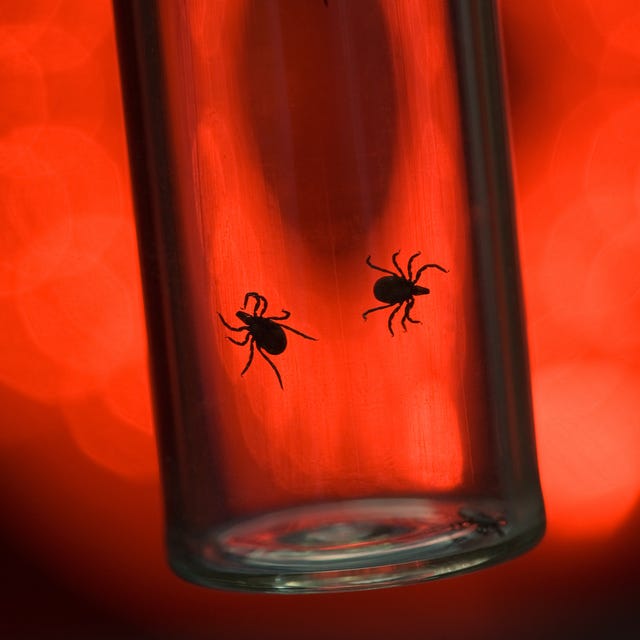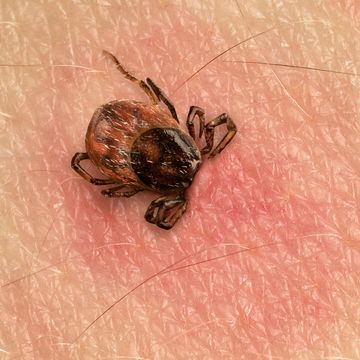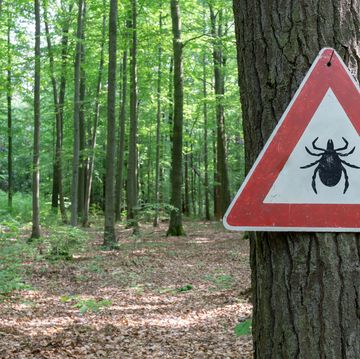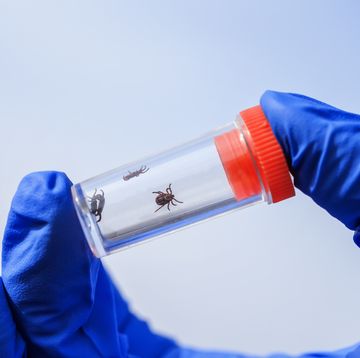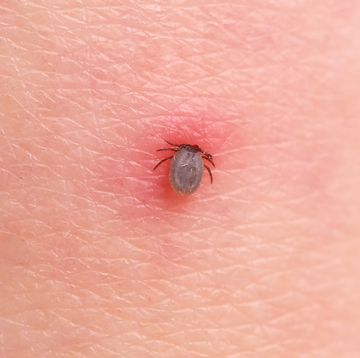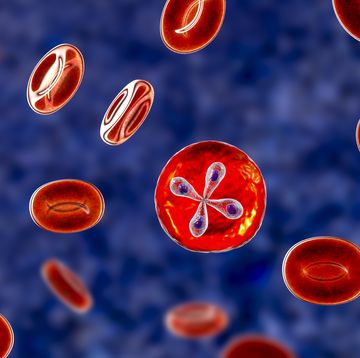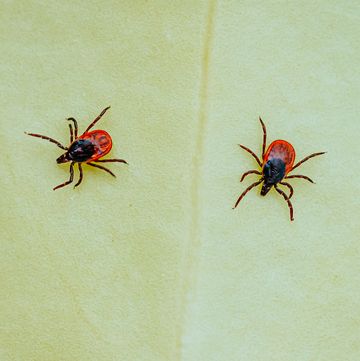Lyme disease is the most common tick-borne illness in the United States, affecting up to 300,000 people a year, according to estimates from the Centers For Disease Control and Prevention (CDC). In certain parts of the country (particularly the Northeast or upper Midwest), checking for ticks is practically a summertime rite of passage.
Experts know that Lyme disease is caused by the bacteria Borrelia burgdorferi, which is transmitted from the bite of an infected blacklegged tick (a.k.a. deer tick). But diagnosing the condition isn’t always so straightforward. Once inside your body, the bacteria can wreak havoc in a number of ways. Yes, that can include the classic bullseye-shaped rash. But many of the other symptoms of Lyme disease aren’t as well known, and they can be frustratingly vague.
That’s why it’s important to familiarize yourself with the signs and seek medical attention ASAP if you think you or a loved one may have Lyme. The disease is typically easy to treat as long as you know what to look for.
Early symptoms of Lyme disease
The first signs of Lyme can strike anywhere from 3 to 30 days after getting bitten by an infected tick, the CDC says.
A red rash
Up to 80% of people will develop a red rash (known as erythema migrans) in the days or weeks after contracting Lyme disease. It usually forms at the site of the tick bite, and the redness is basically an allergic reaction to the tick’s saliva, says Nikhil Bhayani, M.D., an infectious disease specialist at Texas Health Hurst-Euless-Bedford.
Lyme disease rashes will often be bullseye-shaped, but they can also just be a red blotch. The rash will usually expand with time and can get as big as 12 inches. It might feel warm to the touch or look a little crusty in the center where you were bitten, but it won’t be itchy or uncomfortable. While common, it’s still worth noting that some people with Lyme may never develop a rash.
Flu-like symptoms
Not everyone experiences a full laundry list of flu-like symptoms. But there’s a good chance you’ll notice at least a few, Dr. Bhayani says. This potentially includes:
- Fatigue
- Muscle and joint pain
- Headache
- Neck stiffness
- Swollen lymph nodes
- Fever
- Chills
The flu-like symptoms are a result of your immune system’s attempt to fight off the bacterial infection and help you get better, says Kalpana D. Shere-Wolfe, M.D., an infectious disease specialist the University of Maryland Medical Center Midtown Campus.
Of course, these kinds of symptoms could indicate many different illnesses. One clue that a tick bite caused them? With Lyme disease, you won’t experience the coughing or congestion that often comes with the actual flu, Dr. Shere-Wolfe says.
Later Lyme disease symptoms
After a month or so, people infected with Lyme disease may start showing additional symptoms. These can include:
Larger or additional rashes
As the Lyme disease infection spreads throughout the body, your rash might start to expand even more. You might also develop new, smaller rashes nearby. Like the early rash, these might be bullseye-shaped. But they can also just look splotchy or blob-like, according to the CDC. They might even take on a slightly bluish tint in the middle.
Exhaustion, fuzzy thinking, and other cognitive problems
Borrelia burgdorferi is one of the few bacteria that can cross the blood-brain barrier and infect the central nervous system, explains Timothy J. Sellati, Ph.D., Chief Scientific Officer for the Global Lyme Alliance. That can lead to inflammation of the brain, which can affect your central nervous system function in a few different ways.
One of those is extreme fatigue, which affects as many as 76% of people with advanced Lyme disease, according to research. Trouble concentrating, loss of coordination, and short-term memory loss are other possible problems, occurring in up to 24% of people. In extreme cases where the disease is left untreated for extended periods, you might even develop facial weakness and behavioral changes, Sellati says.
Intense headaches
The same inflammation that causes fatigue and fuzzy thinking can also lead to headaches, which findings suggest could strike in up to 70% of people with Lyme disease.
Usually, these feel intense and more similar to a migraine than your run of the mill tension headache, Dr. Bhayani says. In addition to throbbing pain, you might also experience hypersensitivity to noise or light.
Severe pain, numbness, or tingling in your joints and muscles
Around 60% of patients will develop joint pain or even arthritis as their Lyme disease progresses, according to a Johns Hopkins University School of Medicine study. Usually, it starts in the joints closest to where you were bitten and can spread from there, especially to areas like the knees. The pain isn’t usually constant, though. Experts don’t fully understand why, but “the symptoms can wax and wane over a period of weeks or months,” Sellati says.
Over time, the disease can attack the cartilage in the joints and lead to tissue damage, says Linda Yancey, M.D., an infectious disease specialist with Memorial Hermann Katy Hospital in Katy, TX.
Like many of the other problems caused by Lyme disease, this one is also triggered by inflammation. “The damage to tissues, bone, and cartilage is caused by the production of pro-inflammatory proteins, the same protein responsible for damage caused by rheumatoid arthritis,” Sellati says.
Heart palpitations, dizziness, or shortness of breath
In addition to invading the central nervous system, Borrelia burgdorferi can make its way into heart tissue. That can cause the tissue to become inflamed, leading to heart palpitations, Sellati explains. It might feel like your heart is pounding, fluttering, or beating faster than usual.
Usually, it becomes more noticeable with vigorous exercise or stress. The problem isn’t all that common, affecting only around 11% of patients. Still, it can be serious. “If [palpitations] occur frequently, seem to get worse, or are accompanied by chest pain, fainting, severe shortness of breath, or dizziness, you should seek immediate medical attention,” Sellati says.
One thing to note: Generally, shortness of breath is most likely to strike when you’re exerting yourself, but with Lyme that isn’t always the case. “A Lyme disease patient can experience shortness of breath during normal activity that in the past might not have resulted in this response,” Sellati explains.
When to see your doctor about Lyme disease symptoms
It’s best to seek medical attention sooner rather than later. The longer Lyme disease goes untreated, the more likely you are to develop severe complications like intense joint pain, heart problems, or cognitive issues.
Lyme disease treatment: Your doctor should refer you to an infectious disease specialist, who can evaluate your symptoms and decide whether you need testing, Dr. Yancey says. If you test positive, you’ll be given antibiotics to fight the infection.
False-negatives: If your test comes back clean, but you’re convinced that Lyme disease is the culprit, ask to be retested. False negatives are common early on since it takes a few weeks for your immune system to build up antibodies to the bacteria.
Support from readers like you helps us do our best work. Go here to subscribe to Prevention and get 12 FREE gifts. And sign up for our FREE newsletter here for daily health, nutrition, and fitness advice.

